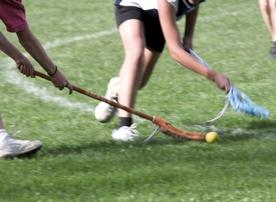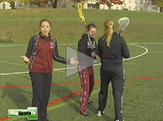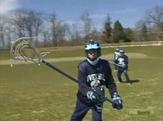10 Important Girls’ Lacrosse Rules for Beginners

A girls' lacrosse player can't check an empty stick.
Get your youngsters in the game
By Craig Haley
PlaySportsTV Managing Editor
A girls’ lacrosse coach who is teaching beginners must explain the sport’s rules as much as skills. Girls have to learn field dynamics as well as how to legally catch, pass and shoot a ball.
Safety is a big part of coaching lacrosse. Following are 10 important US Lacrosse rules to coach with your girls’ lacrosse players:
(Learn how to coach young players with PSTV lacrosse training plans. Hear's how to teach players to catch the ball on their weak side.)
Draw control motion. On draw controls, the two opposing players must move the ball with an up-and-away motion with their lacrosse sticks. A downward or outward motion is illegal, and the ball is awarded to the non-offending team with a free position.
Restraining line. An offside is called when a team has more than seven players on or over the restraining line in its offensive end or more than eight players on or over the restraining line in its defensive end.
3-second rule. Girls’ lacrosse encourages ball movement when the person with the ball is closely guarded within the restraining area. The offensive player has three seconds to pass the ball or change her cradle – either switching her hands or the level she is holding the ball. If the ball remains stationary for more than three seconds, the referee awards the defense with a free position. This lacrosse rule is exempt if the offensive player is behind the goal and the defensive player guarding her is in front of the goal and mirroring her.
Avoid the goalie circle. Players must stay out of the goalie circle. A goal does not count if the shooter or another offensive player steps on or into the goal circle or interferes with the goalie. A defensive player can reach her stick inside the goal circle to block or redirect a shot. Below the ninth-grade level, a shooter may not follow through with her lacrosse stick into the goalie circle.
Free position or indirect free position. The penalty for fouls is a free position. When a team is awarded the ball after a foul, the player can run, pass or shoot it. However, an indirect free position is awarded for minor defensive fouls inside the 12-meter fan, and the player who restarts the ball can’t shoot until a defensive player or a teammate touches it. Only a goalie can take a free position within the 8-meter circle and no free position can be taken within four meters of a field boundary.
Major or minor fouls. All players must stand at least four meters away from the player restarting a free position or indirect free position. On a major foul, the offending player must stand four meters behind the player taking the free position. On a minor foul, the offending player stands four meters away in the direction from which she approached before committing the foul.
Empty stick check. A girls’ lacrosse player can’t check another player’s stick that isn’t in contact with the ball. This applies only when the opponent could have gained possession of the ball.
Offensive charging. A girls’ lacrosse player with the ball cannot push into a defensive player who has established position. This major foul often occurs within the 12-meter fan when a player is going toward the goal.
Dangerous propelling. A player cannot maneuver the ball in her lacrosse stick in a dangerous manner and without regard to the people around her.
Pick or screen? An illegal screen occurs when a player without the ball, by her positioning, forces an opponent to take another route. To be legal, the player must be set within the visual field of the opponent, allowing the defender time and space to change her direction.
###
For more great girls' lacrosse tips, check out PSTV's complete collection of girls' lacrosse videos.








